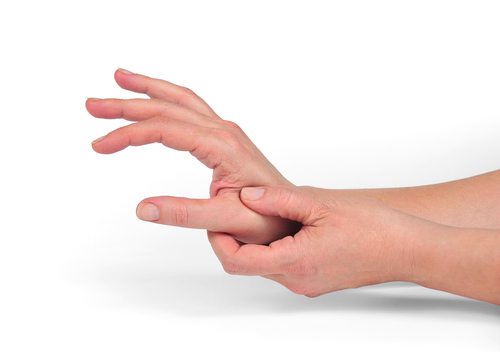Thumb Arthritis Causes, Symptoms, Diagnosis and Treatment

What Is Thumb Arthritis?
Thumb arthritis is common with aging, and occurs when cartilage wears away from the ends of the bones that form the thumb joint — also known as the carpometacarpal (CMC) joint.
Thumb arthritis can cause severe pain, swelling, and decreased strength and range of motion, making it difficult to do simple tasks, such as turning doorknobs and opening jars.
Treatment generally involves a combination of medication and splints. Severe thumb arthritis might require surgery.
Arthritis of the base of the thumb is more common in women than in men, and usually occurs after 40 years of age. Prior fractures or other injuries to the joint may increase the likelihood of developing this condition.
Causes Of Thumb Arthritis:
Thumb arthritis commonly occurs with aging. Previous trauma or injury to the thumb joint also can cause thumb arthritis.
In a normal thumb joint, cartilage covers the ends of the bones, acting as a cushion and allowing the bones to glide smoothly against each other.
With thumb arthritis, the cartilage that covers the ends of the bones deteriorates, and its smooth surface roughens. The bones then rub against each other, resulting in friction and joint damage.
The damage to the joint might result in growth of new bone along the sides of the existing bone (bone spurs), which can produce noticeable lumps on your thumb joint.
The following factors increase the likelihood of developing thumb arthritis:
- Female sex.
- Age above 40 years.
- Obesity.
- Certain hereditary conditions, such as joint ligament laxity and malformed joints.
- Injuries to your thumb joint, such as fractures and sprains.
- Diseases that change the normal structure and function of cartilage, such as rheumatoid arthritis. Although osteoarthritis is the most common cause of thumb arthritis, rheumatoid arthritis can also affect the CMC joint, usually to a lesser extent than other joints of the hand.
- Activities and jobs that put high stress on the thumb joint.
Symptoms Of Thumb Arthritis:
Signs and symptoms include:
- Pain with activities that involve gripping or pinching, such as turning a key, opening a door, or snapping your fingers
- Swelling and tenderness at the base of the thumb
- An aching discomfort after prolonged use
- Loss of strength in gripping or pinching activities
- An enlarged, “out-of-joint” appearance
- Development of a bony prominence or bump over the joint
- Limited motion
Diagnosis Of Thumb Arthritis:
Thumb arthritis is diagnosed via
- Physical examination
- X-rays
Treatment Of Thumb Arthritis:
The following treatment options are available;
- Splint
- Medications
Over-the counter pain relievers, such as acetaminophen (Tylenol, others), ibuprofen (Advil, Motrin IB, others) or naproxen (Aleve)
Prescription pain relievers, such as celecoxib (Celebrex) or tramadol (Conzip, Ultram) - Injections
long-acting corticosteroid - Surgery
Joint fusion (arthrodesis)
Osteotomy
Trapeziectomy
Joint replacement (arthroplasty)
Related Articles:
Arthritis Symptoms, Causes, Diagnosis and Treatment
Juvenile Rheumatoid Arthritis Symptoms, Causes, Diagnosis and Treatment
Septic Arthritis Symptoms, Causes, Diagnosis and Treatment
Reactive Arthritis Symptoms, Causes, Diagnosis and Treatment
Osteoarthritis Symptoms, Causes, Diagnosis and Treatment
Vitamins & Supplements For Arthritis – Joint Pain
Foods That Your Best Friend When You Are On Arthritis Diet
What Is Arthritis Diet Plan And How Does It Work?
Foods You Should Strictly Avoid If You Are On Arthritis Diet
Rheumatoid Arthritis Diet: The Best Foods to be add
Some Essential Foods to Eat in Rheumatoid Arthritis Diet
By : Natural Health News




